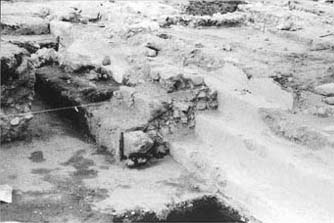| FAMSI © 2006: Michelle Marion Croissier |
||
Excavations at Structure TL5 (N1W6) in the Oaxaca Barrio, Teotihuacán
Research Year: 2003 Table of Contents
Introduction Teotihuacán (México) was the New World's first plural society. The state is thought to have emerged in approximately A.D. 150 and prior to its collapse in approximately A.D. 650 had established ties throughout Classic Period Mesoamerica (e.g. Cowgill 1997). The types of interaction between Teotihuacán and other polities ranged from social-political alliances to legitimize elite status and facilitate interregional trade to the settlement of colonies at strategic locations within long-distance exchange networks (e.g. Braswell 2003; Santley 1989; Winter et al. 2002). The Teotihuacán presence at foreign sites had a local counterpart in the form of several foreign barrios located at the city's periphery. These included the Merchants' Barrio, settled by individuals from the Gulf Coast and Maya areas; the West Mexican Barrio, whose inhabitants' cultural affinities link it to both West México and Oaxaca; and the Oaxaca Barrio, a migrant community with ties to the Oaxaca Valley (e.g. Gomez 2002; Millon 1973; Rattray 1987; Spence 1992). Studies as to the barrios' relationships to their respective society (or societies) of origin and to the Teotihuacán state are ongoing, but findings show that these culturally discrete communities had varied sociopolitical structures and demographic components (e.g. White et al. 2004). The Oaxaca Barrio was a Zapotec enclave–a culturally distinct occupation that is demographically representative of the society of origin and constitutes a minority group located within the boundaries of a foreign state (cf. Spicer 1966). Defined as a whole society, the Oaxaca Barrio differed, for example, from the Merchants' Barrio, which is believed to have been occupied by a single demographic component, namely traders from the Gulf Coast and Maya areas (e.g. Clayton 2005; Rattray 1990). Previous studies of partially excavated apartment compounds show that barrio inhabitants maintained a distinct domestic and mortuary tradition that integrated Oaxaca Valley and Teotihuacán practices (e.g. Rattray 1993; Spence 2002; Spence and Gamboa 1999). We do not, however, know the enclave's practices at the community level. Nor have we been able to resolve the chronological debate. Researchers agree that the barrio was first settled around the 3rd century A.D., at about the same time that a large-scale urban renewal program transformed Teotihuacán and relocated its residents into apartment compounds, but disagree markedly on the length of occupation (e.g. Millon 1973; Paddock 1983; Rattray 1993, 2002; Spence 1992; 2002). This report describes FAMSI-supported archaeological research in 2003 at Structure TL5 (5:N1W6 on the Teotihuacán map) in the Oaxaca Barrio (Millon et al. 1973:70). The archaeological project focused on the enclave's public identity and evaluated the extent of its religious and political autonomy (e.g. Santley et al. 1987). Other project goals were to refine the existing chronology for the barrio and evaluate historical reasons for its presence at Teotihuacán. The excavation simultaneously served as a salvage project, since we anticipate further urban development of this area, which is located outside the protected archaeological zone in the modern town of San Juan Teotihuacán. This report includes: a discussion of field and laboratory methods, a brief description of artifacts and features, a chronology based on ceramics and radiocarbon dates, architectural floor plans of what was most likely the main temple for the enclave; and the results of the preliminary petrography of a select pottery sample of which chemical analysis is ongoing. Click to download the report in PDF format: Excavations at Structure TL5 (N1W6) in the Oaxaca Barrio, Teotihuacán (642 KB) The PDF files require Adobe Acrobat Reader.
Submitted 06/28/2006 by: |
||
| Return to top of page | ||
|
Text links to all pages at this site are available at the FAMSI INDEX |
||
